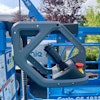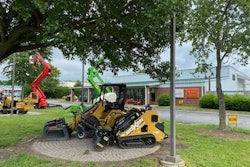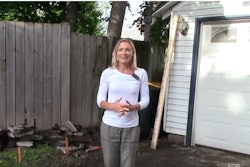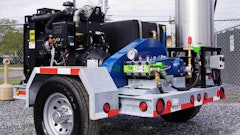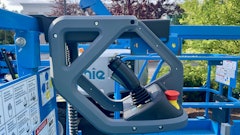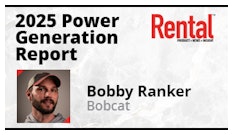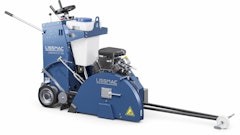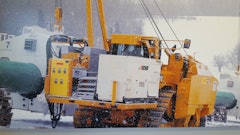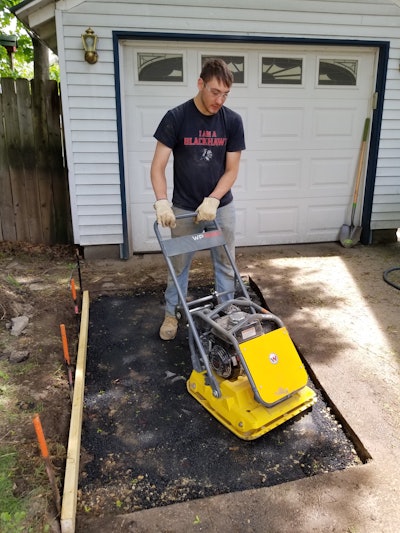
Editor’s Note: Following is an installment in our annual series Renters’ Review, where members of the staff at Rental magazine rent equipment and report on the experience. This review is from 2018, and was originally published in the June/July 2018 issue.
For this year’s Renters’ Review, I decided to investigate repairing my old and very uneven asphalt driveway. It has numerous depressions and “birdbaths,” as they say in the business, with the worst concentration located close to the entrance to my garage, where an accumulation of snow and rain in the winter months contributes to a good size ice skating rink, making a trip to take out the garbage risky business.
I imagined the depressions in this spot, contained within a roughly 8- by 4-foot area, would be easy enough to fill with cold patch asphalt, and in researching how to tackle the project, I stumbled upon some YouTube videos of people doing just that. And it looked easy!
The next step was finding a new rental source that had a plate compactor available.
[VIDEO] Renters' Review 2018: Done With Driveway Depressions
[VIDEO] Renters' Review 2018 Epilogue - Promoting the Value of Rental Expertise
Reassuring rental pro
I Googled “equipment rental” in my area and came up with a good list to work from. As is usual and customary for Renters’ Review projects, I contacted a national chain first, as a point of reference. As expected, I was told they aren’t open on weekends and when I explained the project I was doing and asked if renting a plate compactor made sense, I was given a noncommittal answer and the statement, “I’ve personally never worked with asphalt, so I don’t really know.”
Next, I called a company I’d never heard of. Its website was somewhat uninspiring, but informative enough, and I could see they had a plate compactor in their inventory. So I called and spoke to a fast-talking gentleman who listened as I told him about my project and then gave me his two cents. He said doing an overlay might work okay, but that I should be sure to clean the area thoroughly before patching and that the outcome might benefit from adding sub base in the deepest spots to make the asphalt adhere better. Overall, I was encouraged by his perspective, so I reserved the machine for the following weekend.
One aspect of this company that gave me pause was that I couldn’t find an address on the website. The city was noted, but that was all. When I asked the gentleman I spoke to where he was located, he explained he operates out of a self-storage facility and he would meet me there at 8 a.m. on Friday. Storage unit? I thought. Hmmmm….
Helpful hardware man
Next I needed to obtain my materials, i.e., cold patch asphalt, and I went where I always go, which is Ace Hardware, located two blocks from my house and owned and operated by my friend Jim Goyer, second-generation hardware professional.
I told Jim what I was up to, and he told me he could get me all the cold patch I wanted, but that my plan of doing an asphalt overlay on a driveway depression was flawed.
“You can’t do that,” he said frankly. “You really should cut out the old asphalt first. The patch needs well-defined sides to adhere to.”
“But, but, but…,” I said. “I saw a YouTube video where they did it and it looked really easy and turned out great.”
Jim shook his head and asked me if I had a minute and led me to his office, where he told me about a growing frustration facing hardware stores, and likely rental centers as well.
“You can call it the ‘YouTube effect,’ or even the ‘Pinterest effect’,” he explained. “People see things on video or online and they think it looks easy, and they get a false sense of their abilities. What’s worse is they don’t want to hear it when you tell them it won’t work.
“The thing is, YouTube videos are often produced under ideal working conditions, which is rarely the case in most DIY projects. It’s misleading.”
He continued, “To make matters worse, DIYers will often watch a video, get an idea for how to do something, and then order all their equipment and supplies from Amazon. But guess who they call when things go wrong? They want our advice for free.”
Only a generation or two ago, the hardware store was the first and often the only stop for people tackling household projects. All the supplies were available in one place and the staff always knew how to advise customers on the right way to do something. The same is true in rental, of course, an industry built on the idea of providing customers with solutions. The advent of big box retailers and Amazon have affected consumer behavior, and while hardware store and rental center personnel are still there to help, businesses are feeling the pinch of these alternative channels for getting things done.
And Jim was right, I had been inspired by a video and I did push back when he told me my plan might be flawed. Still, I wasn’t interested in cutting into my asphalt driveway. It seemed dangerous, complicated and fraught with potential damage, threatening to create more expense than I’m willing to put into my driveway right now.
But later that day, I spoke to a friend who works in construction and he said the same thing Jim did. “You can’t do that…” You can imagine how the rest of the conversation went.
To assuage my doubts, I called the manufacturer of Aquaphalt, the premium cold patch I planned to use on the project, and was told “Yes, you can apply an overlay to a driveway depression. Just use a coarser grade (Aquaphalt 6.0) first, and top off with a layer of finer grade (Aquaphalt 4.0).” The trick, they said, was in “feathering” the top layer into the old, existing asphalt.
That’s all I needed to hear. I was going ahead with my original plan.
There are no coincidences
The very next day, I was at a client’s open house luncheon when I randomly sat down at a table with a group of guys. I said hello, and we made small talk while we ate. As we got deeper into our chat, I found out these guys were from none other than the Wayne County (IL) Township Road District. I even happened to be sitting next to Highway Commissioner Martin McManamon. What luck! I told them all about my plan for my driveway repair and their reaction was unanimous. They essentially all exclaimed, “You can’t do that!” when I explained my idea of overlaying my driveway depressions with cold patch.
“You need to cut the old stuff out first,” McManamon said with conviction.
I told him how I was afraid of going past a point of no return with this project, doing real harm to my property and having no recourse for repairing it. I also mentioned it would only be myself and a family friend doing the project and neither of us had any experience with cutting into asphalt.
“It’s easy,” McManamon said. “A cut off saw will go right through it and then you can just pick the asphalt out piece by piece. It’ll come right up with a shovel or pick.”
Not knowing very much about the structure of asphalt driveways, I had imagined the old asphalt would be several inches thick and melded into whatever sub base was under it.
“No, it’s only a couple inches thick and it lays right on top of the gravel or whatever sub base,” McManamon said. “Trust me, it’s easy. If you want the repair to last, you’ll cut out the old stuff first.”
I left the event feeling very anxious about how the project would go. Either I do it the way the video said, and risk it being completely ineffectual, or I do what the professionals say, and significantly complicate the scope and expense of the project, risking (I thought) serious property damage.
There was something reassuring about McManamon’s confidence, however, so it was then I decided to go the full distance on my driveway repair, come what may.
I’m not cut out for this
As mentioned previously, my partner in this project was family friend Josh Rutherford, 20. A big strapping lad tipping the scales at about 200 lbs., I figured he would handle the “heavy lifting,” so to speak, but that I would do the majority of the work on the project. From the minute we got the equipment home, I knew I needed to change my expectations.
First, we had to get a 200-lb. WP 1550 Wacker Neuson plate compactor out of my little Subaru hatchback. I knew I couldn’t be much help with that. In the end, Josh just lifted the thing out of my car and that was that. (Enjoy your youth and strength while you can, kids!)
Next was cutting into the old asphalt. I should add that when we went to the hardware store to get our asphalt, Jim warned us about starting the saw. The rental company supplied us with a Wacker Neuson BTS cut off saw, which he explained has a compression release button and if you forget to press it before starting, the machine just won’t go.
Despite this warning, we were completely mystified when we could not start the saw just a little while later back at my house. So mystified, in fact, that we called the rental company I rented it from. The owner took my call right away and walked us through the procedure (again), gently pointing out the compression release button. Suddenly, it all clicked with what Jim had said and we were good to go. The saw started right up and Josh began cutting.
Just like McManamon said, cutting the old asphalt was like running a hot knife through butter. And Josh took to the saw like a duck to water. When I tried, however, not only could I not start the saw (it felt like my arm wasn’t quite long enough to pull the cord effectively), I couldn’t easily maneuver the 25-lb. machine once it was running.
Humbled by my lack of upper body strength, I let Josh do his thing. He had all the cuts made in no time and proceeded to shovel the old asphalt out with similar ease. Again, I was of little use there, so I stuck to operating the video camera (watch the video here).
Once the hole was cleared of the old asphalt, we could see sand and gravel beneath. As Jim instructed us, we compacted it with the plate, leaving us with a roughly 3-inch depth to fill.
The plate compactor worked like a dream. It started with ease, and was much quieter than I expected. While handling the saw was tough, I had no trouble using the plate compactor. It made easy work of tamping the surface to an even level.
It’s not my fault, it’s asphalt
Before we knew it, it was time to dump the patch material in. We had purchased four buckets of Aquaphalt, each claiming to cover a 5- by 5-ft. area at a 1-in. depth. Upon pouring it into our hole, however, it was immediately obvious this was not the case. We knew Jim had two more buckets back at the store, so we ran to buy those, added them to the hole and were still ridiculously off the mark in terms of coverage.
At this point, it seemed as though my worst fears were coming true. I now had a large, deep hole in my driveway and had already spent a small fortune on the premium asphalt to try to fill it. My blood ran cold as I had visions of a hot mix crew redoing my driveway to the tune of $5,000.
Josh and I considered the options and decided the best course of action was to buy a bunch of the cheapest asphalt we could find and fill the rest of the hole with that. We found an online calculator for figuring asphalt coverage and it looked like we needed 12 50-lb. bags (at $8 each) to fill the rest of the hole. At that point, I just wanted it done.
The calculator was right, 12 bags filled the hole perfectly, but we just made it, with not a piece of aggregate to spare.
It’s an improvement
Asphalt calculators aside, I’m told by some who see the finished project that it could use a couple more bags of asphalt. Maybe so, but I’m well over the thrill of asphalt compaction and ready to call it done. It rained two days after we finished and I was slightly dismayed to discover a bit of water still collects in the lowest spot (which honestly, probably needs a serious overhaul to the soil beneath the sub base to make it really level). But it’s still an improvement, even if it isn’t perfect.
What’s the take-home?
For starters, cold patch asphalt doesn’t behave as you might expect, but is probably not really intended for large patching projects like this anyway. Live and learn.
Second, despite the unusual showroom, the rental business we used was top notch. High-quality, new equipment, plus efficient and responsive service. Who could ask for more?
The answer to that last question is… as efficient and responsive as this rental professional was, he still didn’t display the level of know-how and insight provided by my friendly hardware store. If you’re serving the DIY market, there’s really no substitute that kind of service. Many rental companies offer it, many don’t, but it should always be the ultimate goal.
Thirdly, at nearly 50 years old and not much bigger than the average 12 year old, it’s finally sinking in that I really am physically incapable of certain things. Aside from research and discussion with experts, there wasn’t one step of this project I could have completed on my own. This is no surprise, of course, since it’s been a perennial message from our Renters’ Review features all along: Rental companies need to help customers realize their capabilities but understand their limitations.
Lastly, like Jim said, the rental industry is both bolstered and hindered by the advent of the “YouTube Effect.” Amateur videos are inspirational and can encourage DIYers to visit your rental store to try their hand at projects previously reserved only for professionals. The challenge is in finding a way to gently steer customers away from tasks they clearly are not qualified for without alienating them or driving them elsewhere.
As Jim noted, the “YouTube Effect” is closely related to another modern phenomenon – the “Amazon Effect.” You can easily see how DIYers might watch something done on YouTube, HGTV or Pinterest, and then go straight to their phone to order the supplies off Amazon, at the expense of the rental centers and hardware stores they’d normally visit. The silver lining is when customers come back, knocking on your door when things go wrong, you get to be the hero.
It’s one thing to promote the concept of renting, as well all try to do, but we should never forget to also let DIYers know you have expertise in addition to equipment. As I found out, there can never be too much friendly advice and instruction, even (and maybe especially) when you don’t think you need it.



